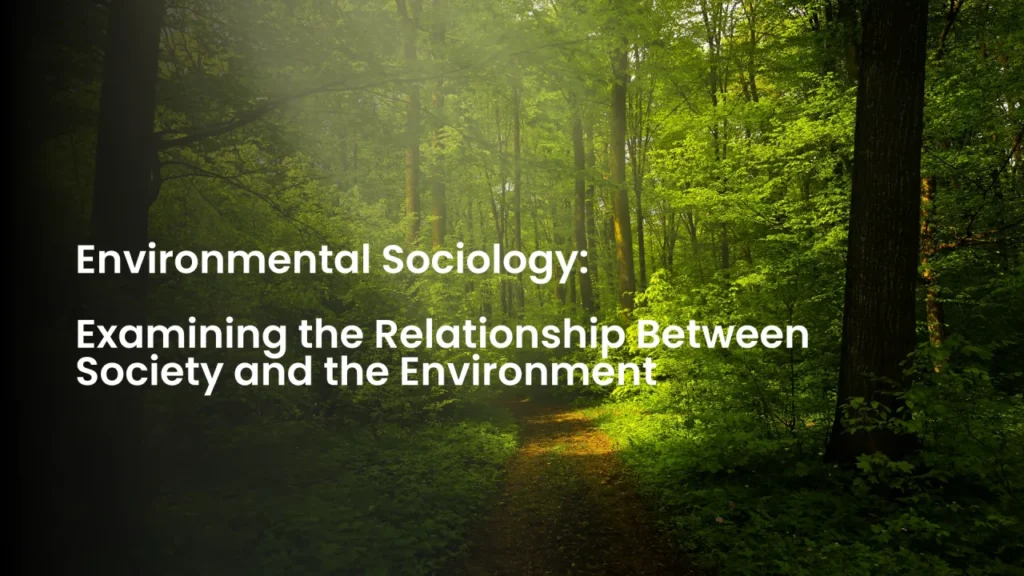In a world where climate change headlines are as common as daily weather reports, understanding the intricate relationship between society and the environment has never been more crucial. Enter environmental sociology—a field that peels back the layers of our social constructs to reveal how they interact with and impact the natural world. Let’s embark on a journey to explore this fascinating discipline, filled with real-world examples and relevance to our current times.
The Genesis of Environmental Sociology
Environmental sociology emerged in the 1970s as a response to growing environmental concerns and the limitations of traditional sociology in addressing these issues. It bridges the gap between sociology and environmental science, examining how social behaviors, structures, and institutions affect the environment and, conversely, how environmental changes impact society.
The Sociological Perspective
Traditional sociology often focused on human interactions and societal structures, somewhat detached from the natural environment. Environmental sociology challenges this by emphasizing that humans are part of an ecological system. It investigates how industrialization, urbanization, and consumption patterns contribute to environmental degradation and how environmental policies and movements shape societal norms and values.
Key Concepts in Environmental Sociology
To grasp the depth of environmental sociology, it’s essential to understand some of its core concepts:
The Treadmill of Production
The treadmill of production theory posits that the continuous pursuit of economic growth leads to environmental degradation. As societies industrialize and prioritize economic expansion, natural resources are exploited, and pollution increases. This theory is evident in the rise of carbon emissions and deforestation linked to economic activities.
Real-World Example: The Amazon Rainforest
The Amazon rainforest, often referred to as the “lungs of the Earth,” is a prime example. Deforestation for agriculture, logging, and mining has accelerated in recent years, driven by the global demand for soy, beef, and other commodities. This not only threatens biodiversity but also contributes to climate change by releasing stored carbon into the atmosphere.
Environmental Justice
Environmental justice examines the uneven distribution of environmental benefits and burdens across different social groups. It highlights how marginalized communities often bear the brunt of environmental hazards, from pollution to climate change impacts, while having limited access to natural resources and green spaces.
Real-World Example: Flint Water Crisis
The Flint water crisis in Michigan, USA, is a stark example of environmental injustice. In 2014, the city switched its water source to the Flint River to save money, resulting in lead contamination that disproportionately affected low-income, predominantly African American residents. The crisis underscored how marginalized communities can suffer from inadequate infrastructure and governmental neglect.
Ecological Modernization
Ecological modernization suggests that technological innovation and sustainable practices can harmonize economic growth with environmental protection. It advocates for integrating environmental considerations into economic and industrial processes, emphasizing that a green economy can drive progress.
Real-World Example: Renewable Energy
The global shift towards renewable energy sources like solar and wind power exemplifies ecological modernization. Countries like Germany and Denmark have invested heavily in renewables, reducing their carbon footprints while maintaining economic growth. This transition showcases how technological advancements can mitigate environmental impacts and foster sustainable development.
The Intersection of Society and Environment
Understanding the interplay between society and the environment involves exploring various dimensions, from cultural attitudes to policy frameworks. Here are some critical intersections:
Cultural Attitudes and Environmental Behavior
Cultural attitudes significantly influence environmental behavior. Societies with strong environmental values often exhibit higher levels of environmental stewardship, from recycling to conservation efforts. Conversely, cultures prioritizing consumerism and material wealth may contribute to environmental degradation.
Real-World Example: Scandinavian Countries
Scandinavian countries, known for their progressive environmental policies, provide insightful examples. In Sweden, the cultural emphasis on “lagom” (moderation) translates into sustainable lifestyles, with high recycling rates and extensive use of public transportation. Similarly, Norway’s commitment to preserving its natural landscapes reflects deep-rooted environmental values.
Policy and Governance
Government policies and governance structures play a pivotal role in shaping environmental outcomes. Effective environmental policies can drive conservation efforts, reduce pollution, and promote sustainable development, while weak governance can exacerbate environmental degradation.
Real-World Example: The Paris Agreement
The Paris Agreement, a landmark international treaty, aims to limit global warming to well below 2 degrees Celsius above pre-industrial levels. It underscores the importance of collaborative global governance in addressing climate change. Countries are required to set national targets for reducing greenhouse gas emissions, demonstrating how policy can steer collective action towards environmental sustainability.
Environmental Movements and Social Change
Environmental sociology also delves into how social movements advocate for environmental protection and influence societal change. These movements raise awareness, mobilize communities, and pressure governments and corporations to adopt sustainable practices.
The Rise of Environmental Activism
Environmental activism has gained momentum, driven by a growing recognition of the urgent need to address environmental challenges. From grassroots organizations to global movements, activists are championing causes ranging from climate action to wildlife conservation.
Real-World Example: Greta Thunberg and Fridays for Future
Swedish teenager Greta Thunberg’s solo school strike for climate action in 2018 sparked a global movement known as Fridays for Future. Millions of young people worldwide have participated in climate strikes, demanding stronger action from political leaders. This movement illustrates the power of youth activism in shaping public discourse and driving policy changes.
Indigenous Environmental Advocacy
Indigenous communities have long been stewards of the environment, advocating for sustainable practices and protecting their ancestral lands. Their knowledge and practices offer valuable insights into sustainable living and environmental conservation.
Real-World Example: Standing Rock Sioux Tribe
The Standing Rock Sioux Tribe’s resistance against the Dakota Access Pipeline is a notable example of Indigenous environmental advocacy. The tribe argued that the pipeline threatened their water supply and sacred sites. Their protest drew international attention and highlighted the role of Indigenous peoples in environmental protection.
The Relevance of Environmental Sociology Today
In an era marked by environmental crises, from wildfires to melting glaciers, environmental sociology offers critical insights into the societal dimensions of these challenges. It underscores the interconnectedness of social and environmental systems and the need for holistic solutions.
Climate Change and Social Inequality
Climate change exacerbates social inequalities, disproportionately affecting vulnerable populations. Environmental sociology sheds light on how marginalized communities are more likely to experience the adverse impacts of climate change, from extreme weather events to food insecurity.
Real-World Example: Pacific Island Nations
Pacific Island nations, such as Kiribati and Tuvalu, are facing existential threats from rising sea levels. These communities, with limited resources and economic power, are on the front lines of climate change, highlighting the intersection of environmental and social vulnerabilities.
Sustainable Development Goals
The United Nations’ Sustainable Development Goals (SDGs) provide a comprehensive framework for addressing global challenges, including environmental sustainability. Environmental sociology contributes to understanding how these goals can be achieved by integrating social and environmental dimensions.
Real-World Example: SDG 13 – Climate Action
SDG 13 focuses on climate action, emphasizing the need for urgent measures to combat climate change and its impacts. Environmental sociology informs the strategies for achieving this goal by examining how social practices, policies, and behaviors can align with climate action efforts.
Conclusion: Embracing a Sustainable Future
Environmental sociology reminds us that society and the environment are inextricably linked. Our actions, policies, and cultural attitudes shape the environment, while environmental changes influence our social structures and well-being. By understanding and addressing these complex interactions, we can work towards a more sustainable and equitable future.
As we navigate the challenges of the 21st century, the insights from environmental sociology will be indispensable. From promoting environmental justice to fostering ecological modernization, this field offers a roadmap for harmonizing human development with the natural world. Let us embrace the wisdom of environmental sociology and strive to create a world where society and the environment coexist in harmony.







